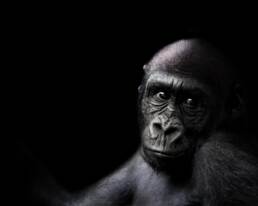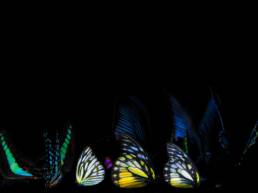ALEXANDRA, HANS-OTTO, WHAT IS YOUR GOAL FOR THE GALLERY?
This gallery conveys our hope to protect the wild places that are still left on our planet and all the animals there that we love so much. Our goal is to get people to care about the planet. We want to try and capture how beautiful the world is. As photographers we want to share what we have encountered and how beautiful it is, to remind people of what is out there and what we must preserve.
ALEXANDRA, WHAT EXCITES YOU MOST ABOUT BEING A PHOTOGRAPHER?
The mundanity of our everyday life tends to keep us inattentive to the world around us. I strongly believe, though, that we need nature to be balanced, happy and fulfilled. For me, nature is the purest and most beautiful thing on Earth. All the modern world’s hustle and bustle fades away when you watch an elephant approaching or some baby lions playing. What drives me is to catch those moments and integrate them into our everyday life. I love having other people look at my work and feel the same calm admiration and excitement that I felt when I took the picture and feel every time I look at it.
HANS-OTTO, ALL OF YOUR SHOTS ARE TAKEN IN THE WILD, RIGHT?
Yes, definitely. That’s our trademark if you want to call it that. We never shoot in a zoo or in an artificial environment. If you see a close-up, for example like the portrait of the shoebill, then yes, it really does mean we were sitting one and a half meters away when we took the photograph. We took this specific shot in Uganda, where we approached the bird with a small boat. The shoebill stood on a bed of sea roses, fishing for his breakfast. He stayed there for about an hour and his curiosity drew him closer and closer. It was an amazing feeling.
QUOTE
"I strive to catch the atmosphere in my photography. The esthetic language of my pictures remains connected to the art history that trained my eye."
— Hans Otto Thomashoff

ALEXANDRA, YOUR MOTTO IS “WHERE NATURE BECOMES ART”—COULD YOU ELABORATE AND HOW DOES IT AFFECT YOUR PICTURES?
It describes the feathery balancing act to find that middle ground between art and nature photography. For us, it is all about composition, lifestyle aesthetics, about the feeling that permeates the picture. This is a main focus for us—that each picture transports you to the very moment it was taken with every aspect involved, while our goal is also to produce something people want to put into their homes. There are a lot of pictures I see in galleries and think, “Oh wow, this is amazing”, but I’d never put it into my living room.
In our pictures we tried to enhance the atmosphere by dimming the light or even chose black and white to carve out what is happening. This is a process of transformation from a sole wildlife shot into something more, deeper, something that makes you feel raw about it but also serves the purpose of completing a room. This is the reason why we chose our motto: “WHERE NATURE BECOMES ART”.
HANS-OTTO, DO YOU CONSIDER NATURE PHOTOGRAPHY AS AN ART?
Art, like beauty, is always is the eye of the beholder. Having studied art history, I like to achieve an arty and even abstract composition. I strive to catch the atmosphere in my photography. The esthetic language of my pictures remains connected to the art history that trained my eye. Out at sea, where life originated, I had the most touching nature experiences of my life. Our oceans are still partly unknown, yet acutely endangered. It is my artistic challenge to capture the intense emotions they evoke like freedom, drama or oceanic peace.
HANS-OTTO, PLEASE TELL US A LITTLE MORE ABOUT YOU AS A PHOTOGRAPHER. DO YOU HAVE A SPECIAL FOCUS ON WHAT YOU WANT TO CAPTURE?
I think I am kind of “omnivorous” as a photographer, photographing everything from great landscapes to huge mammals and even sea birds, well, especially sea birds—they are my passion. (Laugh) But in general, I seek to capture attractive details, esthetic and artistic movements or even textures of skins like elephants have. It always reminds me of a picture of a landscape taken from a plane.
SO, YOUR FAVORITE ANIMALS TO TAKE PICTURES OF ARE BIRDS?
This is hard one: yes and no. I am an ornithologist, having seen more than 3,000 bird species around the globe already so one might assume I am really into birds. But I also enjoy all kind of animals. They are all unique and beautiful, even the ugly ones. (Laughs)
WHAT WAS THE MOMENT THAT MADE YOU BECOME A PHOTOGRAPHER?
Well, as I said, I studied art history together with psychiatry. Art always gave me something of a balance to the more serious subject. But when I think back, it has always been nature I felt most human in, most relaxed. I remember when my parents bought me my first camera—a really simple device—and I set out to the river delta of Dusseldorf, my former hometown, to take pictures of all animals I could find.
ALEXANDRA, WHAT WAS YOUR MOMENT?
In retrospect I think it was when I traveled to Svalbard and took a cruise on a Russian icebreaker. I say my first polar bear—the memory of it still makes me shiver. It was elating, the combination of lost wilderness, the power of that huge carnivore and the lure of untethered freedom. I realized that every moment is fleeting, as we look at it briefly, experience it for a few seconds before it becomes memory. I wanted to catch it, to preserve it, and I found that nature photography was the only way to solidify the memory of wildlife encounters.
QUOTE
"This gallery conveys our hope to protect the wild places that are still left on our planet. As photographers we want to share what we have encountered and how beautiful it is, to remind people of what is out there and what we must preserve."
— Alexandra Diemand

SO, HANS, YOU STARTED WITH OLD-FASHIONED FILM PHOTOGRAPHY?
(Smiles) Indeed, I did. There wasn’t any other option back then. But I have to say that I loved the deliberate approach of film photography, I also loved the moment of surprise of seeing the results of my shots on the light table. Even when they were disappointing. But I also can’t deny the benefits of a modern camera and of instantly seeing the outcome. Back then, when you missed something, you missed it, and you realized it once you were home. Now I say, I missed it—let’s go back and start it all over.
ALEXANDRA, WE WERE DISCUSSING ART. YOU ARE BOTH WRITING BOOKS AS WELL. WHAT DO BOOKS AND PHOTOGRAPHY HAVE IN COMMON?
The most beautiful thing about writing is—as with photography—that you can catch, process, share and preserve experiences and atmospheres, although as a medium books are completely different to digital photography. A lot of our pictures show the grandeur of their subjects, others are endearing, still others remind me either of haunting prose or something calm, light, lyrical. Maybe this is what it makes such a great combination.
DO YOU AGREE, HANS?
I think traveling is an essential part of the creative process—no matter whether it is writing or photography. A lot of famous artists traveled a lot; traveling was their source of inspiration. I always loved traveling. I literally escaped as soon as I could. I spent my eighteenth birthday in Rwanda, having this great experience with mountain gorillas. So for me photography gives me a reason to travel and traveling gives me a reason to write.
PLEASE TELL US ABOUT YOUR GORILLA EXPERIENCE
Sure. Gladly. I, with a group of friends, walked through the jungle, equipped with my old-fashioned camera, when suddenly three huge male mountain gorillas crossed our path. I crouched down to make myself as small as I could—we all did—as the males approached. They were curious and inspected us. I remember this powerful creature very gently grabbing the string of my camera that lay around my neck. I thought, “One pull and I’m done”, but this boy just lifted the camera and then he realized that it was connected to my neck and as soon as he realized that, he put it back down as gently as he could. I was so overwhelmed by this feeling, of this curiosity and natural friendliness, I’ll never forget that.
ALEXANDRA, DO YOU HAVE A SIMILAR MOMENT?
Oh, several. One I remember vividly. We were in Chad. There was the manager of African Parcs in Chad—an amazing organization, by the way—and there was a waterhole where we could take pictures of the elephants. Well, you have to know one thing before I go on. Elephants are very amazing creatures and I learned so much about them, especially on my last trip to Namibia and then on the one to Chad. They are very sensitive. For example, if you shoot an elephant in front of the eyes of his relatives, they get so traumatized they start to destroy all sorts of things and attack other animals and humans. Another thing is, due to the sad fact that they were hunted for so long (and still are), they adapted different behavioral strategies to deal with hunters, or in general, humans. In some regions they kill humans on purpose like in Zambia, in other places, like Chad, they became one large herd, stopping to reproduce and moving around in a group of about four hundred animals. This is unique. The elephants, in this formation, have a chance to build up a kind of a defensive wall, with their tusks on the outside, making it impossible for a predator to break through. For about thirty years, poaching has stopped in Chad, but still the elephants are very afraid of humans and avoid them.
That said, there was a group of three males walking up and suddenly our guide opened the electric fence to give them water with a hose. So, this one huge bull you see on some of our pictures walked up to us, while I sat right there on the ground taking pictures from underneath. It was such an act of trust—for him, but even more for me. But you always feel the animals’ mood and I knew he won’t hurt me. I talked to him all the time—I always talk to animals (laughs)—and we had some sort of connection. He kept looking at me and when our guide handed me the hose, it was my turn to give him more water, and he touched my hand briefly with his trunk. This went on a little until he suddenly started teasing me, touching my chest with his trunk and watering my foot. I guess he just wanted to touch me, to test my reaction, and I guess he thought I might enjoy a shower. It was so scorching hot. But anyway, I’ll never forget that feeling of such power and this trust he showed me and that I showed him. He, to approach us, and me, to sit in front of him at his mercy.
Anyway, I think it is a great sign that they’re starting to walk up to humans again, seeking interaction in a non-violent way. They’ve learned that there are good humans as well and you can clearly see the process: the big herd is gradually starting to split up into smaller groups and they have also started reproducing. This makes me very happy.
